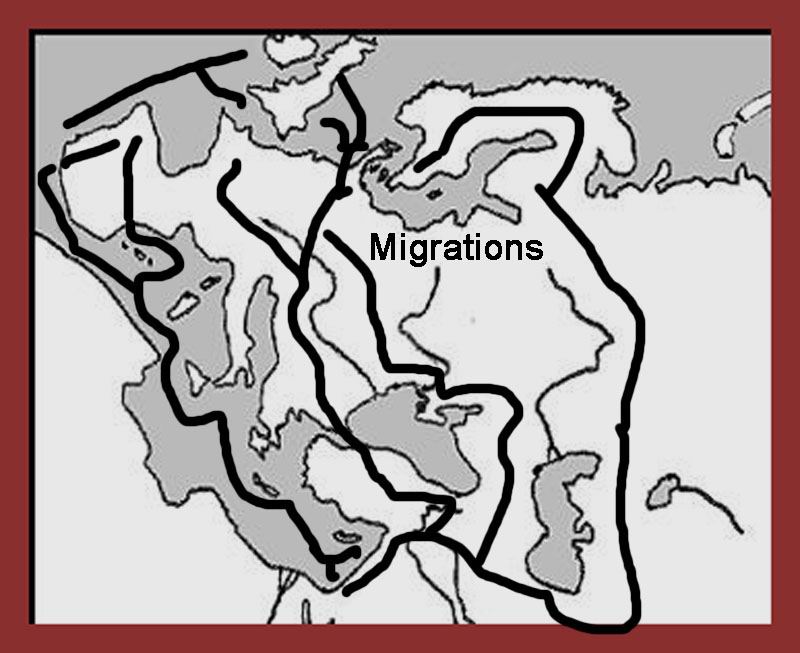Hebrew Inter-mixture with Foreigners (February 10, 2020, 15 Shevet 5780)
Partly Adapted from:
Were the people from the kingdoms of Israel and Judah a relative ethnic group (i.e., were they close genetically)? by Yair Davidiy
========
Contents:
1. Overview
2. Foreign Wives and the Patriarchs
3. Canaanite Nations
4. Failure to Expel All the Canaanite Nations
5. Israelites mixed with Canaanites
6. The Division Between Judah and the rest of Israel
7. The Exile of the Ten Tribes
8. Descendants of Ten Tribes among the Jews and Descendants of Judah with the Ten Tribes
9. Different Physical Types Among the Ancient Israelites
========
1. Overview
The different sections of the Israelite people had a common origin and in Biblical terms are considered brother peoples who are destined to re-unite with each other.
Together with this regional and Tribal differences existed. All Israelite groups intermixed with foreign peoples to some degree. Genetic drift, varying environmental influences, differing types and varied degrees of foreign admixture may also have resulted in something approximating ethnic distinctions. Let us clarify some of these points.
========
2. Foreign Wives and the Patriarchs
The forefathers of the Israelite Nation were fairly homogeneous. Abraham married his niece, Sarah. They begat Isaac. Isaac married Rebecca. She was the daughter of Bethuel the son of Nahor, brother of Abraham. The brother of Rebecca was Laban referred to as the Aramaean, i.e. from Aram. Isaac begat the twins, Esau and Jacob who was re-named Israel (Genesis 32:28, 35:10). JACOB had four wives. Two of his wives, Leah and Rachel, were full-blooded sisters. The other two, Zilpah and Bilhah, were maidservants of Rachel and Leah. According to tradition (see Rashi) they too were daughters of Laban but from wives of a lower status. From these women Jacob begat 12 sons. They were the ancestors of the 12 Tribes of Israel. The sons of Jacob and Leah were Reuben, Simeon, Levi, Judah, Issachar, Zebulon, and a daughter, Dinah. The sons of Jacob and Rachel were Joseph and Benjamin. [Joseph was to have two sons, Ephraim and Manasseh, who were to be regarded as Tribes in their own right, Genesis 48:5]. The sons of Jacob and Zilpah, handmaiden of Leah, were Gad and Asher. The sons of Jacob and Bilhah, handmaiden of Rachel, were Dan and Naphtali.
These children took wives from different peoples.The Bible tells us that Joseph married an Egyptian woman (Genesis 41:45). One of the wives of Judah appears to have been a Canaanitess (Genesis 38:2, 1-Chronicles 2:3).
So too with one of wives of Simeon,
cf.
Exodus 6:
15 The sons of Simeon: Jemuel and Jamin and Ohad and Jachin and Zohar and Shaul the son of a Canaanite woman; these are the families of Simeon.
Machir, the son of Menasseh had an Aramaean concubine (1-Chronicles 7:14).
Later Jewish legends (as recorded in "Seder HaDorot", and "Sefer HaYashar", see also Israel Halperin, "Atlas Etz Haim",1985, vol.2 ;2) tell us that Reuben married a Canaanite Hivitess. Levi and Asher married descendants of Eber, from Shem. Zebulon married a Midianitess while Issachar took a descendant of Sem. Benjamin married a daughter of Zimran, son of Abraham and Keturah. Dan took a daughter of Lot, nephew of Abraham. Naphtali consorted with a daughter descended from Nahor (grandfather of Abraham), as did Gad, and so on. The Apocryphal Book of Jubilees (ca. 200 BCE?) also says that the Tribal Patriarchal heads married women from different nations and mentions Canaanite, Egyptian, Semitic, and Mesopotamian women.
Whether all of the above traditions are accepted or not, they reflect possibilities that existed.
Moses married a Midianite woman described as a Cushitess (Numbers 12:1) and apparently quite dark. Ruth was a Moabitess who married Boaz and from this union King David was descended (Ruth 4:18-22).
When the Israelites conquered Canaan they had been commanded to wipe out or expel all of the Local Canaanite People. They did not do that. Each Tribe left Canaanites within its territory and intermixed with them. There were 12 Canaanite Nations but only 7 of them were dominant in the Land when the Israelites conquered it.
========
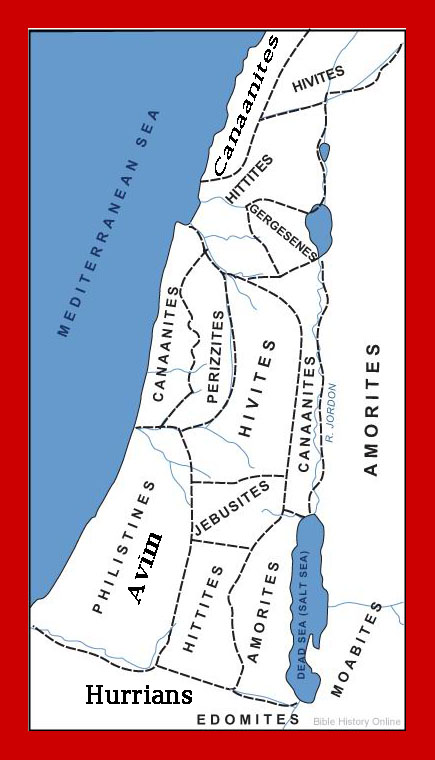
3. Canaanite Nations
The name "Canaan" was, in addition to being a generic name for all of them, also a name of one out of the 12 nations in the Canaanite complex.
These are the 12 Canaanite nations.
Genesis 10:
15 Canaan became the father of Sidon, his firstborn, and Heth 16 and the Jebusite and the Amorite and the Girgashite 17 and the Hivite and the Arkite and the Sinite 18 and the Arvadite and the Zemarite and the Hamathite...
Genesis 17:
8 I will give to you and to your descendants after you, the land of your sojournings, all the land of Canaan, for an everlasting possession; and I will be their God.
Abraham had been promised ALL the Canaanite Lands (Genesis 17:8). Only 7 of these however were to be given to the Israelites when they conquered the land. The Midrash tells us that the other Lands of Canaan will be bequeathed to Israel at a later date.
Exodus 13:5
It shall be when the LORD brings you to the land of the Canaanite, the Hittite, the Amorite, the Hivite and the Jebusite, which He swore to your fathers to give you, a land flowing with milk and honey, that you shall observe this rite in this month.
Here 5 Canaanite Nations are mentioned.
Abraham had been promised ALL the Canaanite Lands (Genesis 17:8). Only 7 of these however were to be given to the Israelites when they conquered the land. The Midrash tells us that the other Lands of Canaan will be bequeathed to Israel at a later date.
Exodus 13:
5 It shall be when the LORD brings you to the land of the Canaanite, the Hittite, the Amorite, the Hivite and the Jebusite, which He swore to your fathers to give you, a land flowing with milk and honey, that you shall observe this rite in this month.
Here 5 Canaanite Nations are mentioned.
Exodus 23:
23 For My angel will go before you and bring you in to the land of the Amorites, the Hittites, the Perizzites, the Canaanites, the Hivites and the Jebusites; and I will completely destroy them.
Here 6 Canaanite Nations are mentioned.
Exodus 23:
28 I will send hornets ahead of you so that they will drive out the Hivites, the Canaanites, and the Hittites before you.
Here 3 Canaanite Nations are mentioned.
Exodus 34:
11 Be sure to observe what I am commanding you this day: behold, I am going to drive out the Amorite before you, and the Canaanite, the Hittite, the Perizzite, the Hivite and the Jebusite.
Here 6 Canaanite Nations are mentioned.
Deuteronomy 7:
1 When the LORD your God brings you into the land where you are entering to possess it, and clears away many nations before you, the Hittites and the Girgashites and the Amorites and the Canaanites and the Perizzites and the Hivites and the Jebusites, seven nations greater and stronger than you...
Here 7 Canaanite Nations are mentioned.
Deuteronomy 20:
17 But you shall utterly destroy them, the Hittite and the Amorite, the Canaanite and the Perizzite, the Hivite and the Jebusite, as the LORD your God has commanded you.
Here 6 Canaanite Nations are mentioned.
Joshua 3:
10 Joshua said, By this you shall know that the living God is among you, and that He will assuredly dispossess from before you the Canaanite, the Hittite, the Hivite, the Perizzite, the Girgashite, the Amorite, and the Jebusite.
Here 7 Canaanite Nations are mentioned.
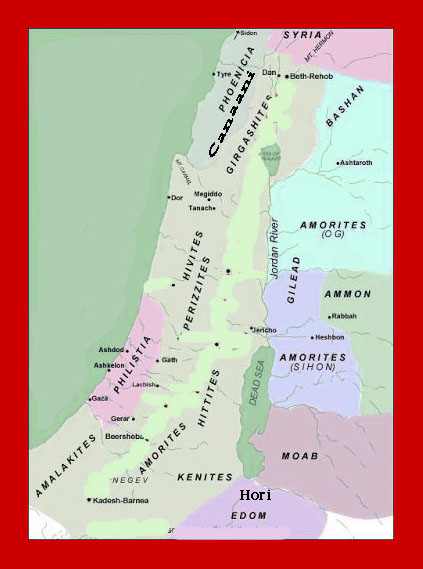
========
4. Failure to Expel All the Canaanite Nations
The Israelites had been commanded to possess all the land and to drive out the Canaanites (Deuteronomy 20:17).
Numbers (NASB) 33:
55 But if you do not drive out the inhabitants of the land from before you, then it shall come about that those whom you let remain of them will become as pricks in your eyes and as thorns in your sides, and they will trouble you in the land in which you live. 56 And as I plan to do to them, so I will do to you.
They did not do this.
Joshua 16:10
But they did not drive out the Canaanites who lived in Gezer, so the Canaanites live in the midst of Ephraim to this day, and they became forced laborers.
Joshua 17:12
But the sons of Manasseh could not take possession of these cities, because the Canaanites persisted in living in that land.
Joshua 17:13
It came about when the sons of Israel became strong, they put the Canaanites to forced labor, but they did not drive them out completely.
Judges 1:
27 But Manasseh did not take possession of Beth-shean and its villages, or Taanach and its villages, or the inhabitants of Dor and its villages, or the inhabitants of Ibleam and its villages, or the inhabitants of Megiddo and its villages; so the Canaanites persisted in living in that land.
Judges 1:
28 It came about when Israel became strong, that they put the Canaanites to forced labor, but they did not drive them out completely.
Judges 1:
29 Ephraim did not drive out the Canaanites who were living in Gezer; so the Canaanites lived in Gezer among them.
Judges 1:
30 Zebulun did not drive out the inhabitants of Kitron, or the inhabitants of Nahalol; so the Canaanites lived among them and became subject to forced labor.
Judges 1:
32 So the Asherites lived among the Canaanites, the inhabitants of the land; for they did not drive them out.
Judges 1:
33 Naphtali did not drive out the inhabitants of Beth-shemesh, or the inhabitants of Beth-anath, but lived among the Canaanites, the inhabitants of the land; and the inhabitants of Beth-shemesh and Beth-anath became forced labor for them.
We see from the above that the Israelites left Canaanite Peoples in the Land alongside of them. Israelites Tribes that are expressly recalled in this regard included Manasseh, Ephraim, Zebulon, Asher, and Naphtali. The Commentary "Daat Mikra" points out that in the case of the Tribe of Naphtali the Canaanites remained in the majority while the Naphtalites lived among them!
========================
5. Israelites mixed with Canaanites
Judges 3:
5 The sons of Israel lived among the Canaanites, the Hittites, the Amorites, the Perizzites, the Hivites, and the Jebusites; 6 and they took their daughters for themselves as wives, and gave their own daughters to their sons, and served their gods.
cf.
Hosea 7:
8 Ephraim mixes with the nations; Ephraim is an unturned cake.
Psalms 106:
35 But they mingled with the Gentiles And learned their works..
========================
6. The Division Between Judah and the rest of Israel
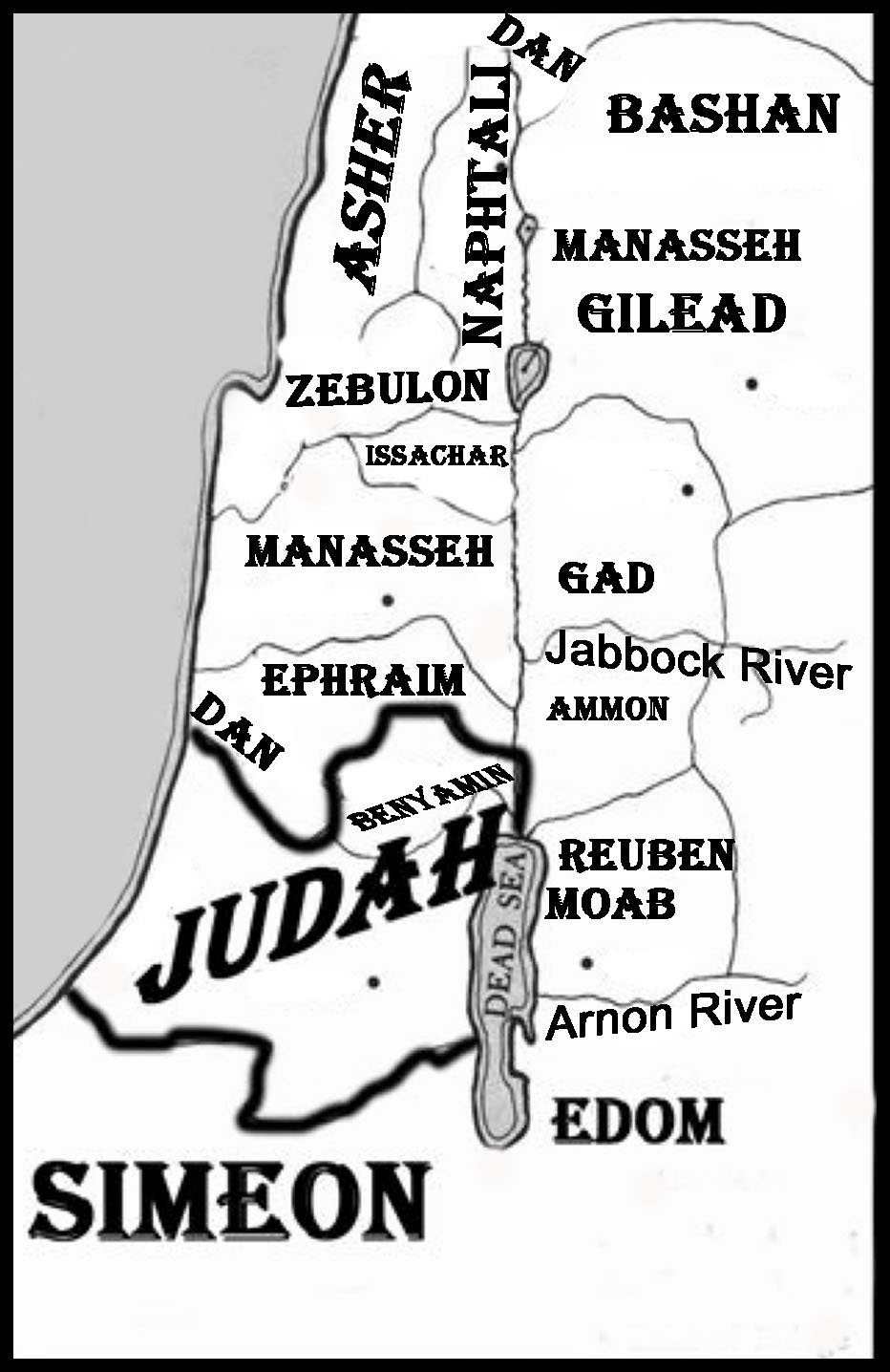
King David at the beginning of his reign only ruled over Judah from Hebron (2-Samuel 2:4). The rest of Israel was under the rule of Ish-Boshet son of Saul (2-Samuel 2:10).
After 2 years Ish-Boshet was assassinated and David became king over all the Israelite Tribes (2-Samuel 5:3). We see from this and from other sources that a certain dichotomy between Judah and the rest of Israel had existed and occasionally come to expression. The son of David was King Solomon who built the Temple in Jerusalem. The Temple area straddled the border line between the Tribe of Judah and the Tribe of Benjamin. After Solomon came Rehoboam. Ten of the Tribes rebelled against Rehoboam and set up their own kingdom under Jeroboam from the Tribe of Ephraim (1-Kings 12:20). This is sometimes referred to as "Israel" especially when it is mentioned in juxtaposition to the Kingdom of Judah. Together with Judah was the Tribe of Benjamin.
The Tribes of Israel who followed Jeroboam were Reuben, Simeon, Issachar, Zebulon, Gad, Asher, Dan, Naphtali, Ephraim, Manasseh. The Tribe of Levi had been scattered throughout all the other Tribes. Jeroboam introduced religious changes so the Levites moved en masse to the Land of Judah (2-Chronicles 11:13).
========================
7. The Exile of Ten Tribes
Later the Assyrians conquered the Northern Kingdom of Israel and exiled all its inhabitants. From their places of Exile they moved to other areas. They came to forget their Israelite origins but retained a degree of communal cohesion.
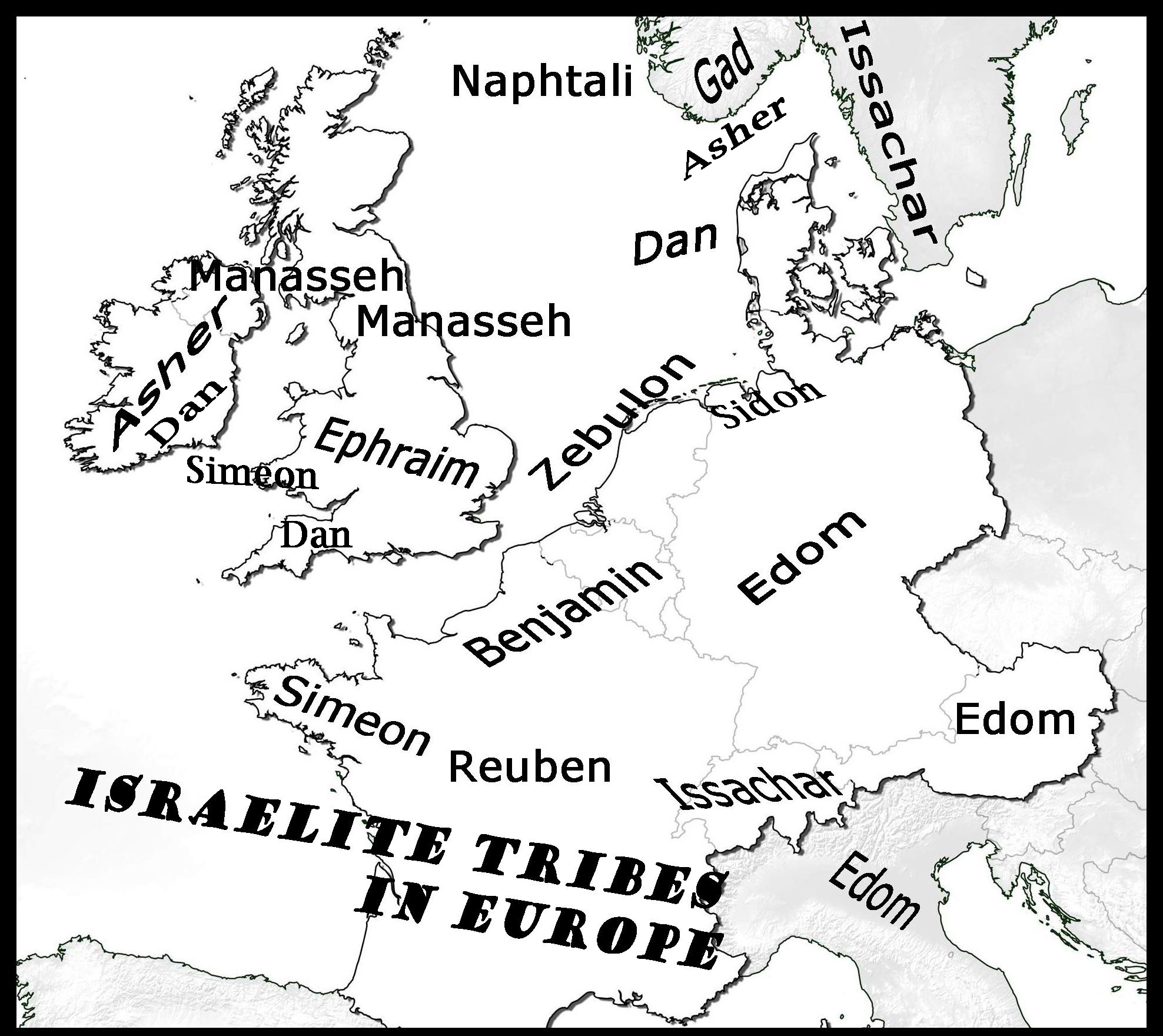
The Exiled Israelites are often referred to as the "Lost Ten Tribes of Israel." Eventually they converged in Western Europe where they gave rise to some of the nationalities in that area.
2-Kings 17:
6 In the ninth year of Hoshea, the king of Assyria captured Samaria and carried Israel away into exile to Assyria, and settled them in Halah and Habor, on the river of Gozan, and in the cities of the Medes.
This happened to them because they had goner in the ways of the nations around them.
2-Kings (NASB) 17:
7 Now this came about because the sons of Israel had sinned against the LORD their God, who had brought them up from the land of Egypt from under the hand of Pharaoh, king of Egypt, and they had feared other gods and walked in the customs of the nations whom the LORD had driven out before the sons of Israel, and in the customs of the kings of Israel which they had introduced.
2-Kings 18:
9 Now in the fourth year of King Hezekiah, which was the seventh year of Hoshea son of Elah king of Israel, Shalmaneser king of Assyria came up against Samaria and besieged it. 10 At the end of three years they captured it; in the sixth year of Hezekiah, which was the ninth year of Hoshea king of Israel, Samaria was captured. 11 Then the king of Assyria carried Israel away into exile to Assyria, and put them in Halah and on the Habor, the river of Gozan, and in the cities of the Medes, 12 because they did not obey the voice of the LORD their God, but transgressed His covenant, even all that Moses the servant of the LORD commanded; they would neither listen nor do it.
========================
8. Descendants of Ten Tribes among the Jews and Descendants of Judah with the Ten Tribes
Many Refugees from the Northern Kingdom had fled to Judah. In this way amongst the Jews are to be found representatives of ALL the Tribes. Nevertheless, Judah, Benjamin, and Levi were the dominant Tribes. Nachmanides in the Book of Redemption discusses this at length.
On the other hand, many from the Kingdom of Judah were also taken away to Assyria.
Isaiah 36:
1 Now in the fourteenth year of King Hezekiah, Sennacherib king of Assyria came up against all the fortified cities of Judah and seized them.
According to the Midrash and an inscription of Sennacherib the Assyrians exiled inhabitants of the towns of Judah they had seized. The number of Exiles from Judah comprised a good portion of the population. They joined the Ten Tribes in Exile.
Nevertheless, Scripture relates to the Jews who remained as Judah and to the Exiles as "Israel," or "Samaria,' or "Ephraim," or "Joseph."
========================
9. Different Physical Types Among the Ancient Israelites

We have seen how the Israelites had intermixed with Canaanite and other peoples.
According to linguistic and archaeological findings different Canaanite peoples had also intermixed with others and were of varying types. Varying degrees of Canaanite blood and differences between the Canaanite nations who contributed to the Israelite "Genome" would have added to the sum total of differing phenotypes within the Israelite nation.
Jacob (i.e. Israel) had a twin-brother named Esau (Genesis 25:25). He who was an "Admoni" i.e. red-haired. The term "Admoni" is sometimes translated as "ruddy" but it more correctly means "red-" or "golden-haired." David, King of Israel, was also an "Admoni" (1-Samuel 16:2) meaning red or golden haired. Laban, the father-in-law of Jacob has a name meaning "Whitish" and which is cognate with the English word "blond." On the other hand, the Shepherdess in the Song of Solomon (1:6) announces, "I am black but comely..." though here too she indicates that she is unlike the daughters of Jerusalem in this regard. It was shown above how the Tribal Patriarchs took women from different nations. In the course of time the separate genetic potentials combined with differing environments would have produced distinctly different types. The area of ancient Israelite settlement contained climates varying from the semi-tropical to the Alpine.
An article on Quora has discussed how today even in the USA people from different areas acquire recognizable characteristics and a "look" of their own.
The Israelites of old were regarded by the Egyptians as people from the Land of Amuru, meaning the Land of the Amorites. The Amorites were one of the Canaanite Peoples but in Egyptian, and sometimes also Biblical, writings they came to represent the Canaanites in general (cf. Genesis 15:16, 48:22, Deuteronomy 1:27, 2-Kings 21:11, Amos 2:10). Another term applied to the general Syrian area was "Retenu" or "Upper Retenu." People from the area known as "Amuru" or "Retenu" after ca.1400 BCE were presumably Israelites. They are depicted on Egyptian monuments as red, blonde, or black-haired with frequent blue eyes and red beards. In addition darker individuals from these same areas are also depicted and sometimes they are the majority. The identification of the "Amuru" people depicted with Israelites may be confirmed from illustrations of an Egyptian monarch and his campaign against the Tribes of Israel: In about 924 BCE the king of Egypt, Shishak, invaded Judah and the (then) separate state of North Israel. Pictures of the campaign of Shishak reveal him receiving homage from the King of Judah and from the heads of cities and dignitaries in Judah and throughout northern ISRAEL. The personages depicted are of "Amuru" type and these pictures are sometimes even used as typifying the Egyptian depiction of "Amuru" characteristics. In the said context "Amuru" in effect often meant Israelite.
The ancient Hebrews were a people of mixed kinds. One Midrash (Genesis Rabah 98;5) says that amongst the Tribes of Simeon and Levi were very light-colored types ("bohakanim"). On the other hand, a Talmudic source (Mishna Negaim 2;1) says that Israelites (meaning in this case, the Jews of Judah) are mainly of an intermediate type coloring being neither black like a "Cushi" (Negro) nor light like a "Germani". The term "Germani" in Talmudic terms (see the work "Aruch HaShalem") meant someone from the far north at that time or who looked like people from that area. The term could be applied (Maimonides) to a very light colored person like part of the people of Scandinavia. Joseph, the son of Israel, was described in a Midrash (Genesis Rabah 86;3) , as looking like a "GERMANI" i.e. like someone from the North, "very white", fair, according to Maimonides. In another passage (Talmud Sota 36) Joseph is spoken of as having a face that was "pink like a rose".
Taking all these sources together and others like them we gain the impression that the Ancient Israelites even before their exile were of mixed types and that in some areas one kind or other tended to predominate.

